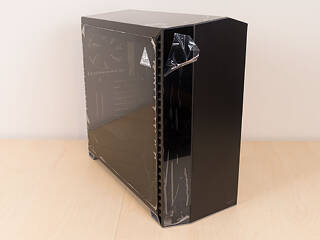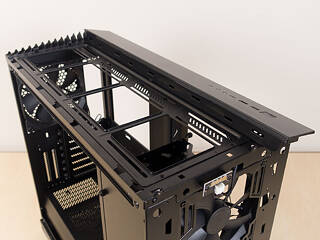 23
23
Fractal Design Vector RS Review
A Closer Look - Inside »A Closer Look - Outside
Out of the box, the Fractal Design Vector RS sports quite the different design from what Fractal is usually known for. With their cases usually being symmetrical, clean, and lacking LED lighting and even RGB, the Vector RS tries to walk the line between being understated and appealing to gamers who want more glass and RGB lighting as well. To achieve this, Fractal Design has taken the excellent frame we have seen in the Define R6 and created panels constructed partially of glass.
Looking at the front, you can clearly see the left glass strip, which is visually separated from the rest of the solid cover with an RGB LED strip. You may pull the whole contraption off to reveal two retail-grade 140 mm intake fans. In the rear, things look just like in the Define R6, with the general system layout pretty traditional.
Fractal Design made sure that there are dust filters on all intake areas. This includes a full length dust filter on the underside of the Vector RS you may pull out through the front, and removable strips in the front panel.
Looking at the rear, the PSU bay is equipped with a mounting frame, as you will have to slide the power supply in through the back of the chassis during assembly. Above that are the seven vertical and two horizontal expansion slots. With the optional Flex VRC-25 PCIe ribbon cable and slot, the two horizontal openings allow you to present your high-end GPU perfectly behind the glass window, for example. In the very top is another retail-grade fan—also a 140 mm unit, it is set to blow air out the back. This brings the total number of cooling units to a very respectable three.
Looking at the main glass side panel, it is quite heavily tinted. Fractal Design has chosen to offer the case in two essential variants: a lightly tinted version and a TG model with a darker hue on the glass. Interesting is also that the glass panel has been placed on a metal frame such that it is secured just like a classic, solid side panel, which results in a very clean glass side panel without any mounting hardware sticking out the side. The opposite side of our Vector RS sample is completely solid as this is where you will route all your cables anyways.
The top is divided up similarly to the front with a large glass panel on the left and a slimmer, solid piece on the right. Once again there is an RGB LED strip that divides these two components. The I/O consists of two USB 3.0, one USB 3.1 Gen2 Type-C, and the usual audio ports. Interestingly enough, Fractal has omitted the HDD activity LED, which seems to be a new industry approach.
Before we dive into the interior of the chassis, let's take a look at the alternate covers provided for the Vector RS. First, you need to remove the front to detach two screws holding the top glass panel in place. Once removed, place the mounting frame for three 120 mm fans or two 140 mm variants with the so called "storage layout", which is the default configuration the Vector RS ships in. With the chassis in "open layout", you will be able to fit three 140 mm fans or a 420 mm radiator. A dust filter and high quality vented top panel allow you to keep dirt out and complement the overall design just as with the glass panel.
Apr 11th, 2025 08:29 EDT
change timezone
Latest GPU Drivers
New Forum Posts
- What's your latest tech purchase? (23512)
- I need help finding the correct vBIOS for my Chinese graphics card. It's an RX 580 (3)
- DTS DCH Driver for Realtek HDA [DTS:X APO4 + DTS Interactive] (2132)
- MSI 4090 Pump Out Is Real (7)
- Your PC ATM (35347)
- GPU-Z Version 2.65.0 - Initialization Failed [BUG] (8)
- Looking for input on fan placement for my Define R5 (24)
- SK hynix A-Die (Overclocking thread) only for RYZEN AM5 users (18)
- 9070XT or 7900XT or 7900XTX (186)
- RX 9000 series GPU Owners Club (287)
Popular Reviews
- The Last Of Us Part 2 Performance Benchmark Review - 30 GPUs Compared
- Thermaltake TR100 Review
- ASRock Z890 Taichi OCF Review
- Zotac GeForce RTX 5070 Ti Amp Extreme Review
- Sapphire Radeon RX 9070 XT Pulse Review
- Sapphire Radeon RX 9070 XT Nitro+ Review - Beating NVIDIA
- Acer Predator GM9000 2 TB Review
- Upcoming Hardware Launches 2025 (Updated Apr 2025)
- PowerColor Radeon RX 9070 Hellhound Review
- MCHOSE L7 Pro Review
Controversial News Posts
- NVIDIA GeForce RTX 5060 Ti 16 GB SKU Likely Launching at $499, According to Supply Chain Leak (179)
- MSI Doesn't Plan Radeon RX 9000 Series GPUs, Skips AMD RDNA 4 Generation Entirely (146)
- Microsoft Introduces Copilot for Gaming (124)
- AMD Radeon RX 9070 XT Reportedly Outperforms RTX 5080 Through Undervolting (119)
- NVIDIA Reportedly Prepares GeForce RTX 5060 and RTX 5060 Ti Unveil Tomorrow (115)
- NVIDIA Sends MSRP Numbers to Partners: GeForce RTX 5060 Ti 8 GB at $379, RTX 5060 Ti 16 GB at $429 (110)
- Nintendo Confirms That Switch 2 Joy-Cons Will Not Utilize Hall Effect Stick Technology (103)
- Over 200,000 Sold Radeon RX 9070 and RX 9070 XT GPUs? AMD Says No Number was Given (100)















